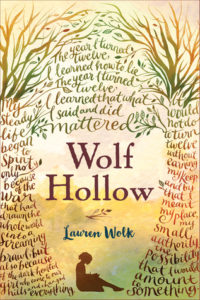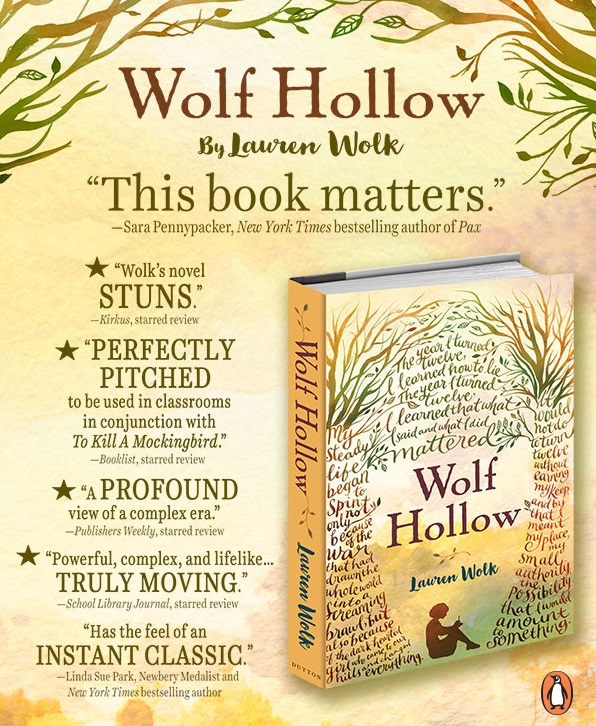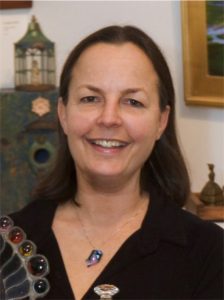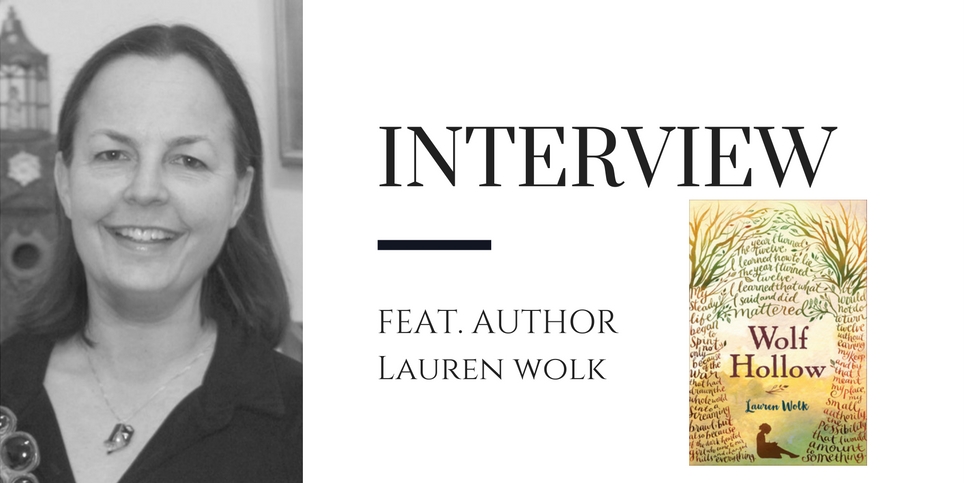The Children’s Book Review | October 8, 2016
An Authentic, Magical, Complex Look at Wolf Hollow
Denise Mealy: What inspired you to write WOLF HOLLOW? How are you familiar with the time period and the rural farm life?
Lauren Wolk: My mother’s stories of her childhood on a small farm in western Pennsylvania inspired Wolf Hollow. So did many, many wonderful visits there, from the time I was a baby right up until my grandmother died at 96, in 2014. Three generations of that farming family taught me about life during World War II—through stories and hundreds of photographs (yes, a picture of my mother and her brothers really did win a camera and a lifetime of film)—but the farm itself taught me about rural life. Not much changed from my mother’s childhood to my own. The farm was the same beautiful place where everyone worked very hard and valued simple things, like gathering on the porch when a storm moved through, or sitting around the kitchen table at night, peeling apples for pies, or picking anything and everything ripe, from peaches and melons to tomatoes and raspberries. It was a hard, magical, unforgettable way of life, and I miss it very much.
The setting of WOLF HOLLOW is a big part of the book. Is it an actual place? Have you been there? Tell us about the inspiration for the turtle rock.
Wolf Hollow runs through our family farm. It really did get its name from the pits that farmers once dug there to trap wolves. My uncle Cal lives there now in a log cabin he built himself. He and my mother and their brother Harry walked through the hollow to get to school. And I explored it quite a lot when I was a kid. It’s a haunting place. But there’s no Turtle Stone. I imagined that, along with most other things in the book, to give Annabelle a way to learn about her place in the scheme of things, her moment in time, her relationship to everything else in the universe.
Betty Glengarry is a special type of villain. We get a sense that she is hurting too, and that her pain from a missing father and being sent away from her mother causes her to lash out. Can you tell us more about it?
I wanted to make Betty an authentic, complex human being, so I gave her cruelty some context, if not an excuse. But she’s meant to be bad to the bone. I hoped to create through Betty a microcosm of what was happening in the war. A ferocious bully and his sidekicks were murdering and terrorizing the world. Bringing out the worst in people, and sometimes the best. And Betty was doing the same on a much smaller scale in Wolf Hollow. Her own personal hurt may have fueled her desire to hurt others, but it was not a reason. There really is no reason for bullying. No reasonable reason.
Who do you envision reading this book? I felt that middle school aged kids through adults would enjoy the book on different levels. What aspects of the book do you think will resonate with different levels of readers?
I actually wrote Wolf Hollow for adults, though I’m thrilled to think that young people are reading it. I was such an insatiable reader when I was a girl that I understand the power of books to educate, entertain, illuminate, and inspire, and I’m very happy to think that Wolf Hollow might play such a role in the lives of children. I know from speaking with three generations of readers (so far) that people who remember the ‘40s respond emotionally to the story and the setting: if they grew up in the countryside, they relive their childhood; if they didn’t, they seem to wish they had. Children relate to Annabelle’s predicaments are inspired by her courage. There have always been bullies, and they have always tended to be vicious cowards, so children today can relate to Annabelle, despite the differences in their lives. And readers of all ages are drawn to the relationships between Annabelle and her brothers, parents, grandparents. It’s what we all want: that closeness. That belonging.
Your writing is beautifully crafted. Can you tell us a bit about your background in poetry, and how it informs your writing? How does your poetry infuse the prose of the book?
I started writing poetry when I was very young. I loved the feeling of creating something that had never before existed, that was essentially mine, in a way few other things were. A good metaphor is a very satisfying thing, for both writer and reader. Sensory details, cadence, very carefully chosen words … they all add up to something unique. But I love writing poetry so much that I have to restrain myself when writing prose. Writing in the first person helps. It keeps me from getting overly involved with the language itself. But I love infusing prose with poetic lines when I can. It’s interesting that my mother’s stories inspired Wolf Hollow, but my own poem, called Wolf Hollow, Pennsylvania, was like a seed, really, that sprouted and put down roots and produced the novel. (see attached)
Can you tell us about your other book, as well as your poetry? How is writing for children vs. adults similar and different? Do you find one more difficult than the other?
I wrote my first novel, Those Who Favor Fire, for adults. It was inspired by a tiny newspaper article about a coal fire burning under a town in Pennsylvania and how that fire affected the people living there. That setting gave me the opportunity to do what I love: to create layers in characters, in their physical world, in the conflicts they face. The same is true of my poetry. And I always aim for the “turn.” The moment when a poem becomes something unexpected, opens a door to a deeper layer. Writing Wolf Hollow was therefore no different than writing for adults. My goal was, as always, to create strong characters and follow them through the layers of their lives. Annabelle took me on a great journey, during which I paid every bit of attention to her and the other people in her world, not to an eventual audience of readers. And when I wrote my next novel, fully aware that it would be for a young audience, the same held true. My process did not change one bit.
What was your journey to becoming an author?
I don’t believe that people become writers. They can become better writers, if they work at the craft and read a lot of good books, but they are born with the desire and the tools to write. That doesn’t mean they know from the start what their potential is. Sometimes, we discover things about ourselves that have been dormant, waiting for the right moment to rise. That happened to me with visual art. What a wonderful surprise to learn, in my thirties, that I had an untapped vein. But writing, for me, has been a part of my life from childhood. My mother tells me that I spoke in metaphors long before I could actually write, which underscores an essential truth about art of any kind: it’s an expression of something bred in the bone.
Can you tell us about your writing method? Plotter or pants-ter?
Ha! I’ve never heard that term: “pants-ter.” But that’s exactly what I am. I never want to know, in either poetry or prose, what’s coming. I know where to start, but I don’t want to know where I’ll finish. Writing is therefore a process of discovery on many levels. Surprises. Adventure. Epiphany. All of which are incredible exciting and satisfying.
How long does it take for you to write a novel? Do you have a critique group or writing partners who review it?
I write very quickly. Wolf Hollow took three months. So did my next book. A story itself pours out as quickly as I let it. Having a very demanding full-time job keeps me from writing as quickly as I’d like, but that’s probably a good thing. While I’m at work, a part of my brain is busy with the book, so when I sit down to write it’s like pulling a plug. But of course I spend lots of time with the incredibly creative and satisfying revision process. And my writers’ group is part of that process. The Bass River Revisionists. A wonderful group of mostly poets. We meet just once each month, but I go with questions and they help me arrive at answers. I also count on a few individuals to read the entire manuscript and give me their impressions. It’s important to have smart, insightful, and, most importantly, honest readers during the revision process.
What does a typical writing day look like for you?
I rarely have writing “days.” I usually get up very early, drink some coffee, and sit down at the computer in my pajamas. And I write until the last possible moment before I have to dive into the shower, throw on some clothes, and race off to work. If I have a whole day to write, I start the same way. And then, somewhere around two o’clock, I shake myself free and head for the shower, get properly dressed, eat some lunch, and go straight back to the computer until I have to stop. I get in a zone. It’s lovely.
What advice can you give aspiring writers?
Write all the time. Read all the time: short stories, poems, novels, articles, essays, cartoons, cereal boxes. Pay attention. I think that may be the seminal thing: paying attention to the world. Eavesdrop on people. Watch them. Listen. Look for the stories unfolding everywhere, sometimes in small and simple ways. Pay attention. To details. To ironies. To the unexpected. To the entire, amazing, confusing world. Pay attention.
Who are some of your favorite authors?
I have very eclectic taste and, oh, maybe a hundred favorite authors. Over the course of my reading life, I have loved E.B. White, Scott O’dell, Roald Dahl, Jane Austin, Emily Brontë, Terence Hanbury White, William Faulkner, Charles Frazier, Tim Winton, Toni Morrison, Harper Lee, Flannery O’Connor, Yann Martel, Mark Haddon, Annie Proulx, Anne Lamott, Anthony Doerr…. How much time do we have? How much ink? And don’t get me started on poets: William Stafford, Billy Collins, Sharon Olds, Mary Oliver, Archibald MacLeish (I’m in my pajamas as I write this. If I didn’t have to go to work, the list would be novel-long.) Did I say I have a hundred favorites? Make that a thousand.
Thanks for allowing this interview! I loved the book!
Thank you!
***
Wolf Hollow, Pennsylvania
They used to dig ditches here to catch wolves.
Deep gashes stitched with roots,
slick with melt,
baited with deer necks
that drew the wolves in,
even the mothers, full of pups.
All night long, they fell and fell,
brewed fog with their own heat,
dug everywhere only to find
endless earth and darkness
and the bones of other buried things.
In the morning, they barked
and shied and bared their muddy teeth
at the farmers who shot them from above
and cut off their ears for the bounty.
The tiny ears of the pups,
born on the tip of a knife,
were like pink rose petals
that curled and stiffened
in my hand as they dried.
That is what I remember best
of the year before I was old enough
to hold a shovel or a gun.
***
 Wolf Hollow
Wolf Hollow
Written by Lauren Wolk
Publisher’s Synopsis: Growing up in the shadows cast by two world wars, Annabelle has lived a mostly quiet, steady life in her small Pennsylvania town. Until the day new student Betty Glengarry walks into her class. Betty quickly reveals herself to be cruel and manipulative, and while her bullying seems isolated at first, things quickly escalate, and reclusive World War I veteran Toby becomes a target of her attacks. While others have always seen Toby’s strangeness, Annabelle knows only kindness. She will soon need to find the courage to stand as a lone voice of justice as tensions mount.
Brilliantly crafted, Wolf Hollow is a haunting tale of America at a crossroads and a time when one girl’s resilience and strength help to illuminate the darkest corners of our history.
“The honesty of Wolf Hollow will just about shred your heart, but Annabelle’s courage and compassion will restore it to you, fuller than before. This book matters.” —Sara Pennypacker, New York Times bestselling author of Pax
“An evocative setting, memorable characters, a searing story: Wolf Hollow has stayed with me long after I closed the book. It has the feel of an instant classic.” —Linda Sue Park, Newbery Medalist and New York Times bestselling author
Ages 10-13 | Publisher: Dutton Books for Young Readers | 2016 | ISBN-13: 978-1101994825
Available Here:
Praise For Wolf Hollow
“A book easily read in one sitting, WOLF HOLLOW is a gripping and poignant tale of prejudice and redemption. Highly recommended.” —Denise Mealy, The Children’s Book Review

About Lauren Wolk

Lauren Wolk
Lauren Wolk is an award-winning poet, artist, and author of the adult novel Those Who Favor Fire. She was born in Baltimore and has since lived in California, Rhode Island, Minnesota, Canada, and Ohio. She now lives with her family on Cape Cod. Wolf Hollow is her first novel for young people.
Discover five of Lauren Wolk’s family’s favorite children’s books in the article Five Family Favorites With Lauren Wolk, Author Of Wolf Hollow.
This interview with Lauren Wolk, author of Wolf Hollow, was conducted by Denise Mealy. Follow along with our content tagged with Cats, Chronicle Books, Nature, and Picture Books to discover more great titles.


4 Comments
Pingback: Seawater in the Veins and Words in the Heart: A Q&A with Lauren Wolk | Brightly
Pingback: MRR Product Feature: Wolf Hollow by Lauren Wolk – My Reading Resources
Pingback: Wolf Hollow by Lauren Wolk Novel Study - Slap Happy Larry
Pingback: Wolf Hollow by Lauren Wolk Novel Study – Slap Happy Larry